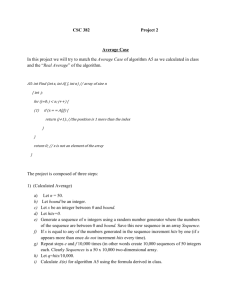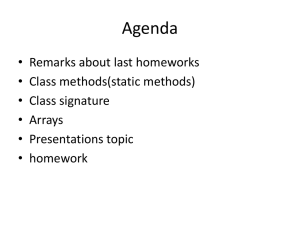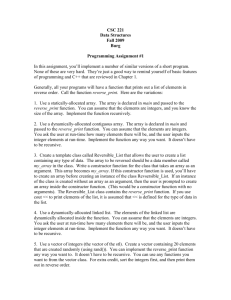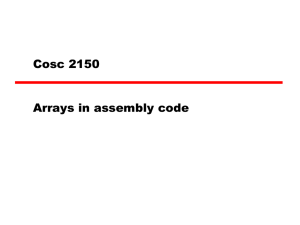Chapter 7 Arrays 7.1 Multiple Choice Questions 1) Unlike regular
advertisement
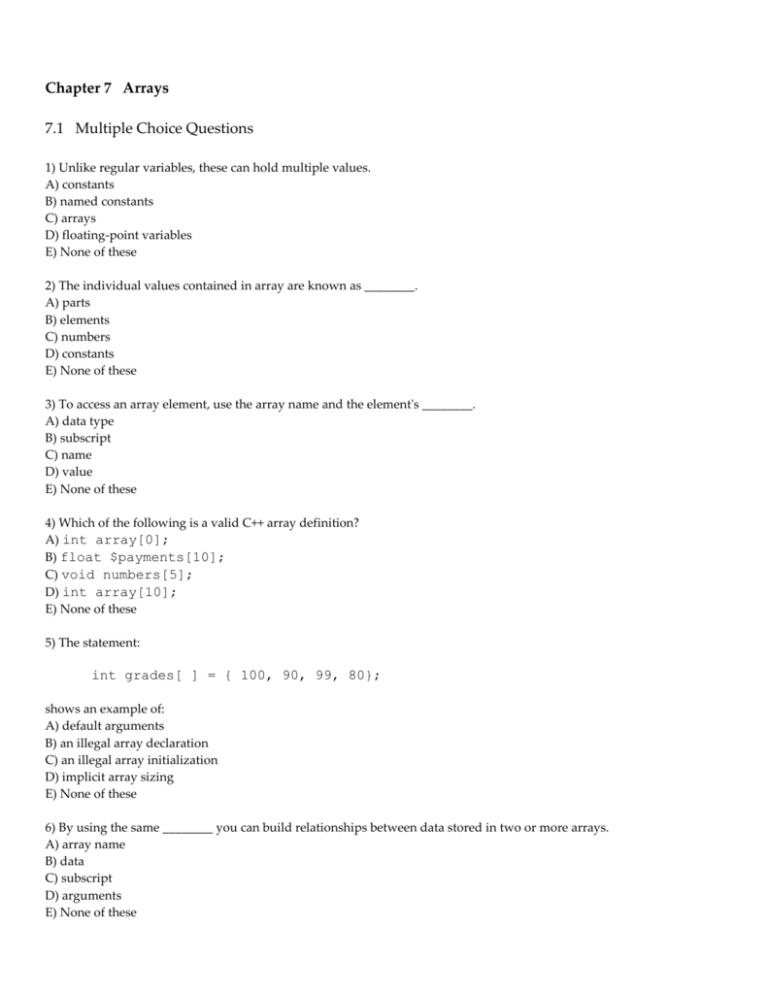
Chapter 7 Arrays
7.1 Multiple Choice Questions
1) Unlike regular variables, these can hold multiple values.
A) constants
B) named constants
C) arrays
D) floating-point variables
E) None of these
2) The individual values contained in array are known as ________.
A) parts
B) elements
C) numbers
D) constants
E) None of these
3) To access an array element, use the array name and the element's ________.
A) data type
B) subscript
C) name
D) value
E) None of these
4) Which of the following is a valid C++ array definition?
A) int array[0];
B) float $payments[10];
C) void numbers[5];
D) int array[10];
E) None of these
5) The statement:
int grades[ ] = { 100, 90, 99, 80};
shows an example of:
A) default arguments
B) an illegal array declaration
C) an illegal array initialization
D) implicit array sizing
E) None of these
6) By using the same ________ you can build relationships between data stored in two or more arrays.
A) array name
B) data
C) subscript
D) arguments
E) None of these
7) The name of an array stores the ________ of the first array element.
A) memory address
B) value
C) element number
D) data type
E) None of these
8) A two-dimensional array is like ________ put together.
A) an array and a function
B) several identical arrays
C) two functions
D) two arrays of different types
E) None of these
9) A two-dimensional array can be viewed as ________ and ________.
A) rows, columns
B) arguments, parameters
C) increments, decrements
D) All of these
E) None of these
10) If you leave out the size declarator in an array definition:
A) you must furnish an initialization list
B) you are not required to initialize the array elements
C) all array elements default to zero values
D) your array will contain no elements
11) Which of the following is a valid C++ array definition?
A) int scores[0];
B) float $payments[10];
C) int readings[4.5];
D) int scores [10];
E) None of these
12) An element of a two-dimensional array is referred to by ________ followed by ________.
A) the array name, the column number of element
B) the row subscript of the element, the column subscript of the element
C) a comma, a semicolon
D) the row subscript of element, the array name
E) None of these
13) When writing functions that accept multi-dimensional arrays as arguments, ________ must be explicitly stated in the
parameter list.
A) all dimensions
B) all but the first dimension
C) the size declarator of the first dimension
D) all element values
E) None of these
14) An array can store a group of values, but the values must be:
A) the same data type
B) each of a different data type
C) constants
D) integers
E) None of these
15) An array's size declarator must be a ________ with a value greater than ________.
A) number, one
B) number, zero
C) constant integer expression, zero
D) variable, -1
E) None of these
16) Subscript numbering in C++________.
A) can be set at runtime
B) can begin with a programmer-defined value
C) varies from program to program
D) begins with zero
E) None of these
17) Arrays may be ________ at the time they are ________.
A) resized, executed
B) re-scoped, deleted
C) initialized, declared
D) pre-compiled, typecast
E) None of these
18) Given the following declaration, where is the value 77 stored in the scores array?
int scores[] = {83, 62, 77, 97};
A) scores[0]
B) scores[1]
C) scores[2]
D) scores[4]
19) An array can easily be stepped through by using a ________.
A) for loop
B) reference variable
C) named constant
D) null value
E) None of these
20) The range-based for loop, in C++ 11, is designed to work with a built-in variable known as the ________.
A) counter variable
B) i variable
C) iterator
D) range variable
E) None of these
21) To assign the contents of one array to another, you must use ________.
A) the assignment operator with the array names
B) the equality operator with the array names
C) a loop to assign the elements of one array to the other array
D) Any of these
E) None of these
22) To pass an array as an argument to a function, pass the ________ of the array.
A) contents
B) size, expressed as an integer
C) name
D) value of the first element
E) None of these
23) A two-dimensional array can have elements of ________ data type(s).
A) one
B) two
C) four
D) Any of these
E) None of these
24) A two-dimensional array of characters can contain ________.
A) strings of the same length
B) strings of different lengths
C) uninitialized elements
D) All of these
E) None of these
25) A(n) ________ can be used to specify the starting values of an array.
A) initialization list
B) array name
C) subscript
D) element
E) None of these
26) The ________ is automatically appended to a character array when it is initialized with a string constant.
A) array name
B) number of elements
C) value of the first element
D) null terminator
E) None of these
27) An array with no elements is ________.
A) legal in C++
B) illegal in C++
C) automatically furnished one element, with a value of zero
D) automatically furnished one value—the null terminator
E) None of these
28) An array of string objects that will hold 5 names would be declared using which statement?
A) string names[5];
B) string names(5);
C) string names5;
D) String[5] names;
E) None of these will work.
29) It is ________ to pass an argument to a function that contains an individual array element, such as numbers[3].
A) illegal in C++
B) legal in C++
C) not recommended by the ANSI committee
D) not good programming practice
E) None of these
30) What is the last legal subscript that can be used with the following array?
int values[5];
A) 0
B) 5
C) 6
D) 4
31) How many elements does the following array have?
int bugs[1000];
A) 1000
B) 999
C) 1001
D) Cannot tell from the code
32) What will the following code display?
int numbers[] = {99, 87, 66, 55, 101 };
cout << numbers[3] << endl;
A) 55
B) 66
C) 101
D) 87
33) What will the following code display?
int numbers[] = { 99, 87, 66, 55, 101 };
for (int i = 1; i < 4; i++)
cout << numbers[i] << endl;
A) 99
87
66
55
101
B) 87
66
55
101
C) 87
66
55
D) Nothing. This code has an error.
34) What will the following code display?
int numbers[4] = { 99, 87 };
cout << numbers[3] << endl;
A) 87
B) 0
C) garbage
D) This code will not compile
35) What will the following code do?
const int SIZE = 5;
double x[SIZE];
for(int i = 2; i <= SIZE; i++)
{
x[i] = 0.0;
}
A) Each element in the array is initialized to 0.0
B) Each element in the array, except the first, is initialized to 0.0
C) Each element in the array, except the first and the last, is initialized to 0.0
D) An error will occur when the code runs
36) Which statement correctly defines a vector object for holding integers?
A) vector v<int>;
B) int vector v;
C) int<vector> v;
D) vector<int> v;
37) Which statement correctly uses C++ 11 to initialize a vector of ints named n with the values 10 and 20?
A) vector n<int>(10, 20);
B) vector<int> n = {10, 20};
C) vector<int> n { 10, 20 };
D) int vector n ({10}, {20});
38) What does the following statement do?
vector<int> v(10);
A) It creates a vector object and initializes all of its elements to the value 10.
B) It creates a vector object with a starting size of 10.
C) It creates a vector object and initializes the first element with the value 10.
D) It creates a vector object that can store only values of 10 or less.
39) What will the following C++ 11 code display ?
vector<int> numbers { 3, 5 };
for (int val : numbers)
cout << val << endl;
A) 5
5
5
B) 3
3
3
3
3
C) 3
5
D) Nothing. This code has an error.
40) What does the following statement do?
vector<int> v(10, 2);
A) It creates a vector object and initializes all the first two elements with the values 10 and 2.
B) It creates a vector object with a starting size of 2 and the first element initialized with the value 10.
C) It creates a vector object with a starting size of 10 and the first element initialized with the value 2.
D) It creates a vector object with a starting size of 10 and all elements are initialized with the value 2.
41) This vector function is used to insert an item into a vector.
A) insert_item
B) add_item
C) store
D) push_back
42) This vector function returns the number of elements in a vector.
A) size
B) num_elements
C) elements
D) length
43) This vector function removes an item from a vector.
A) remove_item
B) delete_item
C) erase
D) pop_back
44) This vector function returns true if the vector has no elements.
A) has_no_elements
B) null_size
C) empty
D) is_empty
7.2 True/False Questions
1) True/False: The amount of memory used by an array depends upon the array's data type and the number of elements
in the array.
2) True/False: The statement:
double money[25.00];
is a valid C++ array definition.
3) True/False: An array initialization list must be placed on one single line.
4) True/False: Assume array1 and array2 are the names of arrays. To assign the contents of array2 to array1, you
would use the following statement.
array1 = array2;
5) True/False: When you pass an array as an argument to a function, the function can modify the contents of the array.
6) True/False: C++ limits the number of array dimensions to two.
7) True/False: If you attempt to store data past an array's boundaries, it is guaranteed that the compiler will issue an
error.
8) True/False: An individual array element can be processed like any other type of C++ variable.
9) True/False: In C++ 11, you cannot use a range-based for loop to modify the contents of an array unless you declare
the range variable as a reference.
10) True/False: In C++ 11, the range-based for loop is best used in situations where you need the element subscript for
some purpose.
11) True/False: Although two-dimensional arrays are a novel idea, there is no known way to pass one to a function.
12) True/False: Each individual element of an array can be accessed by the array name and an element number, called a
subscript.
13) True/False: If an array is partially initialized, the uninitialized elements will be set to zero.
14) True/False: A vector object automatically expands in size to accommodate the items stored in it.




